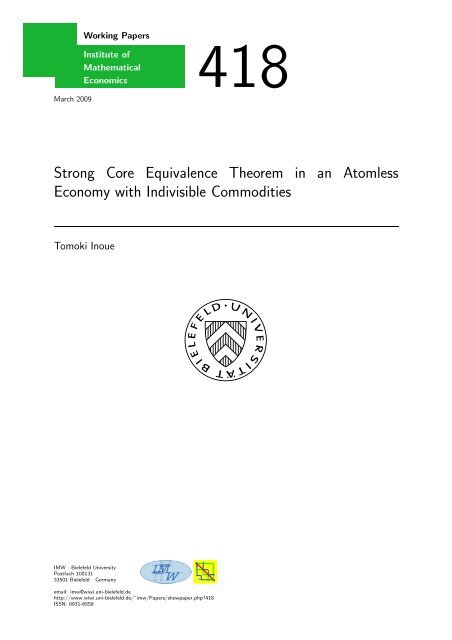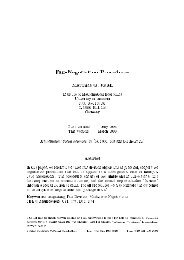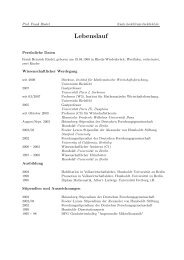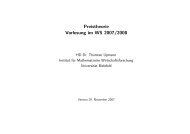download PDF-File - Center for Mathematical Economics
download PDF-File - Center for Mathematical Economics
download PDF-File - Center for Mathematical Economics
Create successful ePaper yourself
Turn your PDF publications into a flip-book with our unique Google optimized e-Paper software.
Working Papers<br />
Institute of<br />
<strong>Mathematical</strong><br />
<strong>Economics</strong><br />
418<br />
March 2009<br />
Strong Core Equivalence Theorem in an Atomless<br />
Economy with Indivisible Commodities<br />
Tomoki Inoue<br />
IMW · Bielefeld University<br />
Postfach 100131<br />
33501 Bielefeld · Germany<br />
email: imw@wiwi.uni-bielefeld.de<br />
http://www.wiwi.uni-bielefeld.de/˜imw/Papers/showpaper.php?418<br />
ISSN: 0931-6558
Strong Core Equivalence Theorem in an Atomless<br />
Economy with Indivisible Commodities<br />
Tomoki Inoue ∗†<br />
March 2009<br />
Abstract<br />
We consider an atomless exchange economy with indivisible commodities. Every<br />
commodity can be consumed only in integer amounts. In such an economy, because<br />
of the indivisibility, the preference maximization does not imply the cost minimization.<br />
We prove that the strong core coincides with the set of cost-minimized Walras<br />
allocations which satisfy both the preference maximization and the cost minimization<br />
under the same price vector.<br />
JEL classification: C71; D51<br />
Keywords: Indivisible commodities; Core equivalence; Strong core; Cost-minimized<br />
Walras equilibrium<br />
1 Introduction<br />
We consider an atomless economy where every commodity can be consumed only in integer<br />
amounts.<br />
In such an economy, agents’ consumption sets are discrete, so transfer of a<br />
small amount of any commodity is impossible; there<strong>for</strong>e, the size of the cores depends<br />
on the improvement defining them.<br />
The notion of the core we focus on is the strong<br />
core. The strong core is defined by the weak improvement which requires that at least<br />
∗ Institute of <strong>Mathematical</strong> <strong>Economics</strong>, Bielefeld University, P.O. Box 100131, 33501 Bielefeld, Germany;<br />
E-mail: tomoki.inoue@gmail.com.<br />
† I acknowledge financial support from the German Research Foundation (DFG).<br />
1
one agent in a coalition can be strictly better off without making other agents in the<br />
coalition worse off. This is the core that Debreu and Scarf [3] used in their limit theorem.<br />
Also, the discreteness of agents’ consumption sets makes their preference relations locally<br />
satiated. Then, the preference maximization does not imply the cost minimization. A<br />
cost-minimized Walras equilibrium is a state where, under some price vector, all agents<br />
satisfy not only the preference maximization but also the cost minimization. We prove<br />
that, in our economy with indivisible commodities, the strong core coincides with the set<br />
of cost-minimized Walras allocations.<br />
Aumann [1] proved that, in an atomless economy with perfectly divisible commodities<br />
and strongly monotone preference relations, the core defined by the strong improvement<br />
coincides with the set of Walras allocations. The strong improvement requires that all<br />
agents in a coalition can be strictly better off. We call the core defined by the strong<br />
improvement the weak core. Although Aumann [1] assumed neither completeness nor<br />
transitivity of preference relations, if agents’ preference relations enjoy these properties<br />
as well as continuity and strong monotonicity, then the weak core is equal to the strong<br />
core. Also, from strong monotonicity of agents’ preference relations, the preference maximization<br />
implies the cost minimization; there<strong>for</strong>e, Walras equilibria coincide with costminimized<br />
Walras equilibria. Hence, Aumann’s [1] theorem implies that, in an atomless<br />
economy with perfectly divisible commodities, the strong core coincides with the set of<br />
cost-minimized Walras allocations. Our core equivalence is a counterpart to Aumann’s<br />
core equivalence in an economy with indivisible commodities.<br />
Because of the discreteness of our commodity space, the strong core and the set of costminimized<br />
Walras allocations can be both empty. If economy has at least one divisible<br />
commodity and if the distribution of agents’ endowment vectors is dispersed, then a (costminimized)<br />
Walras equilibrium exists (see Mas-Colell [8] and Yamazaki [11]). Although<br />
each agent’s demand correspondence may not be upper hemi-continuous at some price<br />
vector, such price vector differs among agents (because the distribution of endowment<br />
vectors is dispersed). Accordingly, by the regularizing effect of aggregation, the aggregate<br />
demand correspondence recovers upper hemi-continuity, and a (cost-minimized) Walras<br />
equilibrium exists. In our economy, however, there is no divisible commodity, and the<br />
regularizing effect does not work enough. There<strong>for</strong>e, a cost-minimized Walras equilibrium<br />
2
may not exist. As an example of an economy where the strong core and the set of costminimized<br />
Walras allocations are nonempty, we give the atomless version of Shapely and<br />
Scarf’s [10] economy. In Shapley and Scarf’s economy with finitely many agents, by the<br />
specification of agents’ preference relations and endowment vectors, every agent consumes<br />
only one unit of only one commodity at any individually rational allocation. Roth and<br />
Postlewaite [9] proved that, if any agent has no indifference among consumptions of one<br />
unit of one commodity, then the strong core coincides with the set of Walras allocations<br />
(which are also cost-minimized Walras allocations by the no-indifference assumption),<br />
and these sets consist of only one allocation. In the atomless version of this economy, the<br />
strong core or, equivalently, the set of cost-minimized Walras allocations is nonempty.<br />
Inoue [7] obtained the same core equivalence in a large finite economy; if agents’ types<br />
are finite and if every type has a sufficiently large number of agents, i.e., there are many<br />
agents who have the same preference relation and the same endowment vector, then the<br />
strong core coincides with the set of cost-minimized Walras allocations. To obtain a bound<br />
of the size of economy such that the core equivalence holds <strong>for</strong> any economy whose size is<br />
larger than the bound. Inoue’s [7] proof is complicated and he put a stronger assumption<br />
on agents’ preference relations than ours. He assumed that any distinct two commodities<br />
are substitutable; there<strong>for</strong>e, the lexicographic preference relation is excluded. In our<br />
atomless model, however, even if some agents’ preference relations are lexicographic, we<br />
can obtain the core equivalence and, by virtue of Lyapunov’s convexity theorem, the proof<br />
is comprehensible.<br />
Inoue [6] considered the same economic model as ours and obtained another type<br />
of core equivalence. Inoue [6] defined the core as an intermediate notion between the<br />
strong core and the weak core, and proved that the core coincides with the set of Walras<br />
allocations. It is worth noting that the usage of the separation theorem <strong>for</strong> convex sets<br />
is different between our proof and Inoue’s [6] proof. To prove that a core allocation is<br />
Walrasian, Inoue [6] applied his separation theorem just once. In contrast, we use a<br />
well-known separation theorem repeatedly. First, by the separation theorem, we find a<br />
price vector under which a strong core allocation satisfies the cost minimization. As the<br />
cost minimization does not imply the preference maximization, on the budget surface<br />
of some agents, there may exist some consumption bundles which are strictly preferred<br />
3
to the strong core allocation. Second, we move the price vector slightly and find a new<br />
price vector under which all agents satisfy both the preference maximization and the cost<br />
minimization. As our commodity space is discrete, even if we move the first obtained<br />
price vector slightly, any consumption bundle which is outside of the budget set under<br />
the first price vector does not enter the new budget set, and we can only put out strictly<br />
preferred consumption bundles on the old budget surface from the new budget set. When<br />
we move the first obtained price vector in an appropriate direction, we use a well-known<br />
separation theorem again.<br />
This paper is organized as follows. In Section 2, we state the model and the main<br />
theorem. In Section 3, we prove the main theorem.<br />
2 Model and Main Theorem<br />
We consider an atomless exchange economy with L indivisible commodities. 1 Every commodity<br />
can be consumed in integer amounts, so the commodity space of our economy is<br />
Z L , where Z is the set of integers. Let (A, A, ν) be an atomless probability space of agents.<br />
For simplicity, we assume that every agent has the same consumption set Z L +. 2 Agent a is<br />
characterized by his preference relation a on Z L + and his endowment vector e(a) ∈ Z L +.<br />
Every preference relation is assumed to be a reflexive, transitive, and complete binary<br />
relation on Z L +. For x, y ∈ Z L +, x y (or equivalently y x) means that consumption<br />
bundle y is at least as good as consumption bundle x with respect to the preference relation<br />
. We denote by P the space of all preference relations. By being endowed the<br />
topology of closed convergence, the space P is separable and complete metrizable. 3 For a<br />
preference relation ∈ P, we define binary relation ≻ as follows: x ≻ y if and only if not<br />
(x y).<br />
A mapping E from the space (A, A, ν) of agents to their characteristics P × Z L +,<br />
E(a) = ( a , e(a)) <strong>for</strong> every a ∈ A, is an economy if E is A/B(P × Z L +)-measurable and<br />
1 In the following model, we use the same notation and the same terminology as Inoue [6].<br />
2 This simplification can be generalized to the universal class X of consumptions sets such that x ≥ b<br />
<strong>for</strong> every x ∈ X and every X ∈ X , and {x ∈ X | x ≤ (k, . . . , k)} ≠ ∅ <strong>for</strong> every X ∈ X , where b and k are<br />
a priori constants. For a more detailed discussion on the universal class, see Hildenbrand [4, pp. 84-86].<br />
3 For the justification <strong>for</strong> the adoption of this topology, see Hildenbrand [4, p. 96].<br />
4
endowment mapping e : A → Z L + is ν-integrable, where B(P × Z L +) is the σ-algebra of<br />
the Borel subsets in P × Z L +.<br />
A mapping f : A → Z L + is an allocation <strong>for</strong> economy<br />
E if it is ν-integrable. An allocation f : A → Z L + <strong>for</strong> economy E is exactly feasible if<br />
∫<br />
A f(a)dν(a) = ∫ A e(a)dν(a).<br />
Because of the indivisibility, the size of the core depends on the improvement defining<br />
it. We focus on the strong core defined by the weak improvement.<br />
Definition 1. Let f : A → Z L + be an allocation <strong>for</strong> economy E. A coalition S ∈ A can<br />
weakly improve upon f if there exists an allocation g <strong>for</strong> E such that ν({a ∈ S | g(a) ≻ a<br />
f(a)}) > 0, g(a) a f(a) ν-a.e. a ∈ S, and ∫ g(a)dν(a) = ∫ e(a)dν(a). The strong core<br />
S S<br />
of E is the set of all exactly feasible allocations that cannot be improved upon by any<br />
coalition and is denoted by C S (E).<br />
The improvement defining the strong core is the same as the improvement defining<br />
Pareto-efficiency. Hence, any strong core allocation is Pareto-efficient.<br />
The core defined by the strong improvement which requires that all agents in a coalition<br />
can be strictly better off is called the weak core. By definition, the strong core is a subset of<br />
the weak core. In our economy, transfer of a small amount of any commodity is impossible;<br />
the strong core can be strictly smaller than the weak core. 4<br />
As we will prove later, the strong core of our economy is completely characterized by<br />
cost-minimized Walras equilibria.<br />
Definition 2. A pair (p, f) of a price vector p ∈ Q L + and an allocation f : A → Z L + <strong>for</strong> E<br />
is a cost-minimized Walras equilibrium <strong>for</strong> E if<br />
(i) f is exactly feasible, i.e., ∫ A f(a)dν(a) = ∫ A e(a)dν(a),<br />
(ii) <strong>for</strong> ν-a.e. a ∈ A, p · f(a) ≤ p · e(a),<br />
(iii) <strong>for</strong> ν-a.e. a ∈ A, if x ∈ Z L + and x ≻ a f(a), then p · x > p · e(a), and<br />
(iv) <strong>for</strong> ν-a.e. a ∈ A, if x ∈ Z L + and x a f(a), then p · x ≥ p · e(a).<br />
4 Inoue [6, Examples 2.5, 2.12, and 3.4] gave an example of an economy such that the nonempty strong<br />
core is a proper subset of the weak core.<br />
5
A cost-minimized Walras allocation is an allocation f <strong>for</strong> which there exists a price vector<br />
p ∈ Q L + such that (p, f) is a cost-minimized Walras equilibrium.<br />
The set of all costminimized<br />
Walras allocations <strong>for</strong> economy E is denoted by W CM (E).<br />
From conditions (i) and (ii), we have p · f(a) = p · e(a) ν-a.e. a ∈ A. 5 Thus, condition<br />
(iii) can be rewritten as “<strong>for</strong> ν-a.e. a ∈ A, f(a) maximizes a in the set {x ∈ Z L + | p · x ≤<br />
p·e(a)}” and, there<strong>for</strong>e, this is the preference maximization condition. Also, condition (iv)<br />
can be rewritten as “<strong>for</strong> ν-a.e. a ∈ A, f(a) minimizes p·x in the set {x ∈ Z L + | x a f(a)}”<br />
and, there<strong>for</strong>e, this is the cost minimization condition.<br />
When a pair (p, f) of a price vector p ∈ Q L + and an allocation f <strong>for</strong> E satisfies conditions<br />
(i)-(iii), it is called a Walras equilibrium <strong>for</strong> E. If agents’ preference relations are locally<br />
nonsatiated, the preference maximization implies the cost minimization. In our economy,<br />
however, any preference relation must be locally satiated, and there can exist a Walras<br />
equilibrium that is not a cost-minimized Walras equilibrium. 6<br />
On the other hand, if the consumption set is convex, the preference relation is continuous,<br />
and the minimum wealth condition is met, then the cost minimization implies the<br />
preference maximization (see Debreu [2, Theorem (1), Section 9, Chapter 4]). This type<br />
of argument cannot be applied to our economy, because our commodity space is discrete.<br />
Thus, in our economy, the cost minimization is not enough to guarantee the preference<br />
maximization.<br />
We require that Walras allocations and strong core allocations are exactly feasible,<br />
that is, free disposal is not permitted. In the case where free disposal is permitted, even<br />
if agents’ preference relations are strongly monotone (in the discrete sense), there can<br />
exist a Walras allocation which is not exactly feasible. 7 In contrast, if agents’ preference<br />
relations satisfy the following desirability condition, any strong core allocation and any<br />
5 This follows also from conditions (i) and (iv).<br />
6 In Inoue’s [6, Examples 2.5, 2.12, and 3.4] economy, the nonempty strong core is a proper subset of<br />
the set of Walras allocations. From our main theorem, the strong core coincides with the set of costminimized<br />
Walras allocations, so this example illustrates that there exists a Walras equilibrium that is<br />
not a cost-minimized Walras equilibrium.<br />
7 Inoue [6, Example 2.5] gave an example of an economy which has a Walras allocation which is not<br />
exactly feasible.<br />
6
cost-minimized Walras allocation are exactly feasible. 8<br />
Definition 3. A preference relation on Z L + is nonsatiated in every positive direction if<br />
<strong>for</strong> every x ∈ Z L + and every l ∈ {1, . . . , L} there exists k ∈ Z ++ such that x + kχ l ≻ x,<br />
where χ l is the lth unit vector.<br />
Note that, even if preference relation is nonsatiated in every positive direction, two<br />
distinct commodities may not be substitutable. In particular, a lexicographic preference<br />
relation is nonsatiated in every positive direction.<br />
We can now state our main result.<br />
Theorem. Let E : (A, A, ν) → P × Z L +<br />
conditions.<br />
be an economy which satisfies the following<br />
(i) For ν-a.e. a ∈ A, preference relation a is nonsatiated in every positive direction.<br />
(ii) The endowment mapping e : A → Z L + is ν-essentially bounded.<br />
Then, the strong core coincides with the set of cost-minimized Walras allocations, i.e.,<br />
C S (E) = W CM (E).<br />
By an argument similar to the proof of the first welfare theorem, we can show that<br />
W CM (E) ⊆ C S (E) <strong>for</strong> every economy E even if E does not satisfy assumption (i) or (ii).<br />
The proof of the opposite inclusion will be given in the next section.<br />
Assumption (ii) means that agents’ endowment vectors have only finite variety. If the<br />
endowment mapping is not essentially bounded, there can exist a strong core allocation<br />
that is not a cost-minimized Walras allocation. 9<br />
From assumption (i), any equilibrium price vector is strictly positive. Hence, from<br />
assumption (ii), we have the following corollary.<br />
8 For the proof of the exact feasibility of strong core allocations, see Inoue [6, Lemma 6.1]. Although<br />
Inoue [6, Lemma 6.1] put a stronger assumption on agents’ preference relations, we can weaken it to the<br />
nonsatiation in every positive direction. The exact feasibility of cost-minimized Walras allocations follows<br />
from the budget constraint (condition (ii)) and the strict positivity of cost-minimized Walras equilibrium<br />
price vector which is guaranteed by the nonsatiation in every positive direction.<br />
9 See Inoue [6, Example 3.3].<br />
7
Corollary. Let E : (A, A, ν) → P × Z L + be an economy which satisfies conditions (i)<br />
and (ii) of the Theorem above. Then, every strong core allocation <strong>for</strong> E is ν-essentially<br />
bounded.<br />
Because of the indivisibility, <strong>for</strong> some economy, the strong core and the set of costminimized<br />
Walras allocations can be both empty. In such case, the equivalence is trivial. 10<br />
The following example gives a sufficient condition <strong>for</strong> these sets to be nonempty. It is<br />
Roth and Postlewaite’s [9] theorem in the atomless version of Shapley and Scarf’s [10]<br />
economy.<br />
Example. Consider an atomless economy with L indivisible commodities and L agents’<br />
types. Let {A 1 , . . . , A L } be a measurable partition of the set A of agents. For every<br />
l ∈ {1, . . . , L}, all agents in A l has the same utility function u l : Z L + → R and the same<br />
endowment vector χ l , the lth unit vector. Every type has the same mass, i.e., ν(A l ) = 1/L<br />
<strong>for</strong> every l ∈ {1, . . . , L}. Every utility function u l satisfies that<br />
(a) min i∈{1,...,L} u l (χ i ) > u l (0), and<br />
(b) u l is injective on {χ 1 , . . . , χ L }, i.e, consuming one unit of one commodity cannot be<br />
indifferent.<br />
The utility level at any vector in Z L + \{0, χ 1 , . . . , χ L } can be specified arbitrarily. They are<br />
not important in this economy. Here, in order to apply our theorem, every u l is assumed<br />
to be nonsatiated in every positive direction. We call this economy E 0 .<br />
In economy E 0 , from assumption (a), every individually rational exactly feasible allocation<br />
f satisfies that f(a) ∈ {χ 1 , . . . , χ L } <strong>for</strong> ν-a.e. a ∈ A. In particular, every strong<br />
core allocation and every Walras allocation enjoy this property. In addition, as a candidate<br />
of a Walras equilibrium price vector, it suffices to consider price vectors p such that<br />
1 < p (l) < 2 <strong>for</strong> every l ∈ {1, . . . , L}; any agent cannot consume more than one unit of<br />
one commodity. Hence, by assumption (b), Walras allocations are cost-minimized Walras<br />
allocations.<br />
Let {a 1 , . . . , a L } be agents such that a l ∈ A l <strong>for</strong> every l. Then, we can consider<br />
Shapley-Scarf economy E ′ with L agents {a 1 , . . . , a L }. By David Gale’s top trading cycle<br />
10 For an example of the empty strong core, see Inoue [6, Example 3.2].<br />
8
algorithm (see Shapley and Scarf [10]), we can find a Walras allocation ¯f : {a 1 , . . . , a L } →<br />
{χ 1 , . . . , χ L } <strong>for</strong> E ′ . From assumption (b), ¯f is the unique Walras allocation <strong>for</strong> E ′ .<br />
Define an allocation f : A → Z L + <strong>for</strong> E 0 by f(a) = ¯f(a l ) if a ∈ A l , l = 1, . . . , L. Since<br />
¯f is the unique Walras allocation <strong>for</strong> E ′ and since Walras allocations are cost-minimized<br />
Walras allocations, we have<br />
W CM (E 0 ) = [f],<br />
where [f] is the set of all allocations g with g = f ν-a.e. Then, by our theorem or by<br />
Roth and Postlewaite’s lemma [9, Lemma 1], 11 we have<br />
C S (E 0 ) = [f] = W CM (E 0 ).<br />
Finally, we give a remark about the relationship with Inoue’s [6] core equivalence<br />
theorem.<br />
Remark. Inoue [6] introduced the core which is an intermediate concept between the<br />
strong core and the weak core. An exactly feasible allocation f <strong>for</strong> economy E : (A, A, ν) →<br />
P × Z L + is a core allocation if there exists no coalition S ∈ A and a mapping g : S → Z L +<br />
such that ν({a ∈ S | g(a) ≻ a f(a)}) > 0, g(a) = f(a) <strong>for</strong> ν-a.e. a ∈ S \ {b ∈ S | g(b) ≻ b<br />
f(b)}, and ∫ g(a)dν(a) = ∫ e(a)dν(a). The core of E is the set of all core allocations<br />
S S<br />
and is denoted by C(E).<br />
By definition, the strong core is a subset of the core. For some economy, the strong<br />
core is a proper subset of the core. 12<br />
Inoue [6] proved that, under the same assumptions as our theorem, 13 the core C(E)<br />
coincides with the set W ∗ (E) of exactly feasible Walras allocations. By combining this<br />
result with ours, we obtain that<br />
W CM (E) = C S (E) ⊆ C(E) = W ∗ (E)<br />
11 From Roth and Postlewaite [9, Lemma 1], any allocation h <strong>for</strong> E ′ with h ≠ ¯f can be weakly improved<br />
upon via ¯f. Thus, any allocation h <strong>for</strong> E 0 with h ∉ [f] can be weakly improved upon via f and, there<strong>for</strong>e,<br />
C S (E 0 ) ⊆ [f].<br />
Since W CM (E 0 ) ⊆ C S (E 0 ) holds (this inclusion holds <strong>for</strong> any economy), we have the<br />
following equalities.<br />
12 For an example, see Inoue [6, Examples 2.5, 2.12, and 3.4].<br />
13 In Inoue’s [6] core equivalence theorem, the assumption on agents’ preference relations can be weakened<br />
to our assumption: nonsatiated in every positive direction.<br />
9
<strong>for</strong> any atomless economy E which satisfies the assumptions of our theorem.<br />
In economy E 0 from the above example, by assumption (b), we have C S (E 0 ) = C(E 0 )<br />
and W CM (E 0 ) = W ∗ (E 0 ) and, there<strong>for</strong>e, W CM (E 0 ) = C S (E 0 ) = C(E 0 ) = W ∗ (E 0 ) = [f].<br />
3 Proof of Theorem<br />
Let E : (A, A, ν) → P × Z L + be an economy which satisfies the assumptions (i) and (ii)<br />
of Theorem. We will only prove the inclusion C S (E) ⊆ W CM (E), because the opposite<br />
inclusion follows from a standard argument. For simplicity, we assume that, <strong>for</strong> every<br />
a ∈ A, a is nonsatiated in every positive direction and endowment mapping e is bounded.<br />
Let f ∈ C S (E). For z ∈ Z L , let<br />
A z = {a ∈ A | z + e(a) ∈ Z L + and z + e(a) a f(a)}<br />
and let<br />
B z = {a ∈ A | z + e(a) ∈ Z L + and z + e(a) ≻ a f(a)}.<br />
Then, A z , B z ∈ A <strong>for</strong> every z ∈ Z L . Define<br />
⎛<br />
A ∗ = A \<br />
⎜<br />
⎝<br />
⋃<br />
z∈Z L<br />
ν(A z)=0<br />
A z ∪<br />
⋃<br />
z∈Z L<br />
ν(B z)=0<br />
⎞<br />
B z<br />
⎟<br />
⎠ .<br />
Then, A ∗ ∈ A and ν(A ∗ ) = 1. Define two correspondences ψ : A ∗ ↠ Z L and ϕ : A ∗ ↠ Z L<br />
as follows:<br />
ψ(a) = {z ∈ Z L | z + e(a) ∈ Z L + and z + e(a) a f(a)} = {x ∈ Z L + | x a f(a)} − {e(a)}<br />
and<br />
ϕ(a) = {z ∈ Z L | z + e(a) ∈ Z L + and z + e(a) ≻ a f(a)} = {x ∈ Z L + | x ≻ a f(a)} − {e(a)}.<br />
Note that ϕ(a) ⊆ ψ(a) <strong>for</strong> every a ∈ A ∗ .<br />
First, we will find a price vector p 0 under which strong core allocation f satisfies the<br />
cost minimization condition, i.e., if x ∈ Z L + and x a f(a), then p 0 · x ≥ p 0 · e(a). Second,<br />
we will move the price vector p 0 slightly and find a price vector ¯p under which f satisfies<br />
10
not only the cost minimization condition but also the preference maximization condition.<br />
The following claim will be used when we find price vector p 0 and when we move p 0 in an<br />
appropriate direction.<br />
Claim 1. Let H be a linear subspace of R L . Assume that ⋃ a∈A ∗ ϕ(a) ∩ H ≠ ∅. Then,<br />
0 ∉ ri ( co (⋃ a∈A ∗ ψ(a) ∩ H )) , where ri(C) and co(C) denote the relative interior and the<br />
convex hull of set C, respectively.<br />
Proof. Suppose, to the contrary, that 0 ∈ ri ( co (⋃ a∈A ∗ ψ(a) ∩ H )) . 14 Let z 0 ∈ ⋃ a∈A ∗ ϕ(a)∩<br />
H. Since A ∗ ∩ B z0 ≠ ∅, we have ν(B z0 ) > 0. From 0 ∈ ri ( co (⋃ a∈A ∗ ψ(a) ∩ H )) and<br />
z 0 ∈ ⋃ a∈A ∗ ϕ(a) ∩ H, it follows that 0 can be represented as a convex combination of z 0<br />
and finitely many points in ⋃ a∈A ∗ ψ(a)∩H, i.e., there exist {z 1 , . . . , z k } ⊆ ⋃ a∈A ∗ ψ(a)∩H<br />
and (α (0) , α (1) , . . . , α (k) ) ∈ R k+1<br />
++ such that ∑ k<br />
j=0 α(j) = 1 and ∑ k<br />
j=0 α(j) z j = 0. For every<br />
j ∈ {1, . . . , k}, since A ∗ ∩ A zj ≠ ∅, we have ν(A zj ) > 0.<br />
Define λ = min{ν(B z0 ), ν(A z1 ), . . . , ν(A zk )} > 0.<br />
By Lyapunov’s theorem, the set<br />
{ν(S) | S ∈ A, S ⊆ B z0 } is convex. Since ν(B z0 ) ≥ λ ≥ λα (0) > 0, there exists an S 0 ∈ A<br />
such that S 0 ⊆ B z0 and ν(S 0 ) = λα (0) .<br />
Assume that we have chosen mutually disjoint sets S 0 , . . . , S m ∈ A such that<br />
S 0 ⊆ B z0 ,<br />
S j ⊆ A zj<br />
ν(S j ) = λα (j)<br />
<strong>for</strong> j ∈ {1, . . . , m}, and<br />
<strong>for</strong> j ∈ {0, 1, . . . , m}.<br />
Again, by Lyapunov’s theorem, the set {ν(S) | S ∈ A, S ⊆ A zm+1 \ ⋃ m<br />
j=0 S j} is convex.<br />
Since<br />
ν<br />
(<br />
A zm+1 \<br />
)<br />
m⋃<br />
S j ≥ ν(A zm+1 ) −<br />
j=0<br />
there exists an S m+1 ∈ A such that<br />
S m+1 ⊆ A zm+1 \<br />
m∑<br />
ν(S j ) ≥ λ − λ<br />
j=0<br />
m∑<br />
α (j) ≥ λα (m+1) > 0,<br />
j=0<br />
m⋃<br />
S j and ν(S m+1 ) = λα (m+1) .<br />
j=0<br />
14 The following argument is essentially the same as Aumann [1, p. 45]. See also Hildenbrand [5, pp.<br />
843-844].<br />
11
There<strong>for</strong>e, we can obtain mutually disjoint sets S 0 , S 1 , . . . , S k ∈ A such that<br />
S 0 ⊆ B z0 ,<br />
S j ⊆ A zj<br />
ν(S j ) = λα (j)<br />
<strong>for</strong> j ∈ {1, . . . , k}, and<br />
Define S = ⋃ k<br />
j=0 S j ∈ A and define g : S → Z L + by<br />
<strong>for</strong> j ∈ {0, 1, . . . , k}.<br />
g(a) = z j + e(a) <strong>for</strong> a ∈ S j (j = 0, 1, . . . , k).<br />
For a ∈ S 0 , since a ∈ B z0 , we have g(a) = z 0 +e(a) ≻ a f(a). Recall that ν(S 0 ) = λα (0) > 0.<br />
For a ∈ S j , j ∈ {1, . . . , k}, since a ∈ A zj , we have g(a) = z j + e(a) a f(a). Furthermore,<br />
we have<br />
∫<br />
S<br />
g(a)dν(a) =<br />
=<br />
=<br />
k∑<br />
∫<br />
z j ν(S j ) +<br />
j=0<br />
k∑<br />
∫<br />
λα (j) z j +<br />
j=0<br />
∫<br />
S<br />
e(a)dν(a).<br />
This contradicts that f is a strong core allocation.<br />
From assumption (i), we have ⋃ a∈A ∗ ϕ(a) ≠ ∅.<br />
S<br />
S<br />
e(a)dν(a)<br />
e(a)dν(a)<br />
Thus, by Claim 1, we have 0 ∉<br />
int ( co (⋃ a∈A ∗ ψ(a) )) . By the separation theorem <strong>for</strong> convex sets, there exists a p 0 ∈<br />
R L \ {0} such that<br />
p 0 · z ≥ 0<br />
<strong>for</strong> all z ∈ co<br />
( ⋃<br />
a∈A ∗ ψ(a)<br />
By assumption (i), co (⋃ a∈A ∗ ψ(a) ) = co (⋃ a∈A ∗ ψ(a) ) + R L +. Hence, we have p 0 ≥ 0.<br />
Claim 2. There exists a ¯p ∈ R L + \ {0} such that<br />
(1) ¯p · z > 0 <strong>for</strong> every z ∈ ⋃ a∈A ∗ ϕ(a), and<br />
(2) ¯p · z ≥ 0 <strong>for</strong> every z ∈ ⋃ a∈A ∗ ψ(a).<br />
)<br />
.<br />
Proof. Let H 0 = {z ∈ R L | p 0 · z = 0}. If ⋃ a∈A<br />
ϕ(a) ∩ H ∗ 0 = ∅, then p 0 has the desired<br />
property. Assume that ⋃ a∈A<br />
ϕ(a) ∩ H ∗ 0 ≠ ∅. Then, by Claim 1, we have<br />
( ( ))<br />
⋃<br />
0 ∉ ri co ψ(a) ∩ H 0 .<br />
a∈A ∗ 12
By the separation theorem <strong>for</strong> convex sets, there exists a p 1 ∈ span (⋃ a∈A ∗ ψ(a) ∩ H 0<br />
)<br />
\{0}<br />
such that p 1 · z ≥ 0 <strong>for</strong> every z ∈ ⋃ a∈A ∗ ψ(a) ∩ H 0 .<br />
Subclaim 2.1. For every j ∈ {1, . . . , L}, if p (j)<br />
0 = 0, then p (j)<br />
1 ≥ 0.<br />
Proof. Suppose, to the contrary, that, <strong>for</strong> some j ∈ {1, . . . , L}, p (j)<br />
0 = 0 and p (j)<br />
1 < 0. Since<br />
⋃<br />
a∈A<br />
ϕ(a) ∩ H ∗ 0 ≠ ∅, there exists an agent b ∈ A ∗ and a net trade vector z 0 ∈ ϕ(b) ∩ H 0 ;<br />
there<strong>for</strong>e,<br />
z 0 + e(b) ∈ Z L + and z 0 + e(b) ≻ b f(b).<br />
Since b is nonsatiated in every positive direction, <strong>for</strong> every n ∈ Z ++ , there exists an<br />
r ≥ n such that<br />
z 0 + e(b) + rχ j ≻ b z 0 + e(b) ≻ b f(b).<br />
There<strong>for</strong>e, z 0 + rχ j ∈ ϕ(b) ⊆ ⋃ a∈A ∗ ψ(a). From p (j)<br />
0 = 0 and z 0 ∈ H 0 , it follows that<br />
z 0 + rχ j ∈ H 0 and, there<strong>for</strong>e, z 0 + rχ j ∈ ⋃ a∈A ∗ ψ(a) ∩ H 0 . By the consequence of the<br />
separation theorem above, we have<br />
0 ≤ p 1 · (z 0 + rχ j ) = p 1 · z 0 + rp (j)<br />
1 .<br />
Since we can make r arbitrarily large, this is a contradiction.<br />
Let E = {z ∈ ⋃ a∈A ∗ ψ(a) | p 0 · z > 0}. Define the set E ′ of minimal elements of E as<br />
follows: x ∈ E ′ if and only if x ∈ E and there exists no y ∈ E with y ≤ x and y ≠ x.<br />
Since endowment mapping e : A → Z L + is bounded, the set E is bounded from below.<br />
Hence, by Gordan’s lemma (see, e.g., Inoue [6, Lemma 5.1]), E ′ is a nonempty finite set<br />
and satisfies that E ⊆ E ′ + Z L +. Since p 0 ≥ 0, we have<br />
inf{p 0 · z | z ∈ E} = min{p 0 · z | z ∈ E ′ } > 0.<br />
Since the mapping p ↦→ min{p·z | z ∈ E ′ } is continuous, there exists an open neighborhood<br />
U 0 of p 0 such that, <strong>for</strong> every p ∈ U 0 , min{p · z | z ∈ E ′ } > 0.<br />
For sufficiently small ε 1 > 0, p 0 + ε 1 p 1 ∈ U and, <strong>for</strong> every j ∈ {1, . . . , L} with p (j)<br />
0 > 0,<br />
p (j)<br />
0 + ε 1 p (j)<br />
1 > 0 holds. By Subclaim 2.1, we have p 0 + ε 1 p 1 ≥ 0. By construction, if<br />
p (j)<br />
0 + ε 1 p (j)<br />
1 = 0, then p (j)<br />
0 = 0. There<strong>for</strong>e,<br />
0 < min{(p 0 + ε 1 p 1 ) · z | z ∈ E ′ } = inf{(p 0 + ε 1 p 1 ) · z | z ∈ E}.<br />
Hence, we have obtained that<br />
13
(a) p 0 + ε 1 p 1 ∈ R L + \ {0},<br />
(b) if p (j)<br />
0 > 0, then p (j)<br />
0 + ε 1 p (j)<br />
1 > 0,<br />
(c) (p 0 + ε 1 p 1 ) · z > 0 <strong>for</strong> every z ∈ ⋃ a∈A ∗ ψ(a) \ H 0 , and<br />
(d) (p 0 + ε 1 p 1 ) · z ≥ 0 <strong>for</strong> every z ∈ ⋃ a∈A ∗ ψ(a) ∩ H 0 .<br />
Let H 1 = {z ∈ R L | (p 0 + ε 1 p 1 ) · z = 0}. If ⋃ a∈A ∗ ϕ(a) ∩ H 0 ∩ H 1 = ∅, then p 0 + ε 1 p 1<br />
has the desired property. Assume that ⋃ a∈A ∗ ϕ(a) ∩ H 0 ∩ H 1 ≠ ∅. Then, by the same<br />
argument as above, there exists a p 2 ∈ span (⋃ a∈A ∗ ψ(a) ∩ H 0 ∩ H 1<br />
)<br />
\ {0} and an ε2 > 0<br />
such that<br />
(a ′ ) p 0 + ε 1 p 1 + ε 2 p 2 ∈ R L + \ {0},<br />
(b ′ ) if p (j)<br />
0 + ε 1 p (j)<br />
1 > 0, then p (j)<br />
0 + ε 1 p (j)<br />
1 + ε 2 p (j)<br />
2 > 0,<br />
(c ′ ) (p 0 + ε 1 p 1 + ε 2 p 2 ) · z > 0 <strong>for</strong> every z ∈ ⋃ a∈A ∗ ψ(a) \ (H 0 ∪ H 1 ), and<br />
(d ′ ) (p 0 + ε 1 p 1 + ε 2 p 2 ) · z ≥ 0 <strong>for</strong> every z ∈ ⋃ a∈A ∗ ψ(a) ∩ H 0 ∩ H 1 .<br />
Since dim(H 0 ∩ H 1 ) = dim H 0 − 1 and since 0 ∉ ⋃ a∈A ∗ ϕ(a), by repeating this argument,<br />
in at most L steps, say, in m steps, we obtain that ⋃ a∈A ∗ ϕ(a) ∩ H 0 ∩ · · · ∩ H m−1 = ∅.<br />
Price vector p 0 + ∑ m−1<br />
i=1 ε ip i has the desired property.<br />
Let F = {z ∈ ⋃ a∈A ∗ ψ(a) | ¯p · z > 0} and V = span{z ∈ ⋃ a∈A ∗ ψ(a) | ¯p · z = 0}. Since<br />
f(a) − e(a) ∈ ψ(a) <strong>for</strong> every a ∈ A ∗ , by Claim 2, we have<br />
Thus, by the exact feasibility of f, we have<br />
¯p · (f(a) − e(a)) ≥ 0 <strong>for</strong> every a ∈ A ∗ .<br />
¯p · (f(a) − e(a)) = 0 <strong>for</strong> ν-a.e. a ∈ A ∗ .<br />
There<strong>for</strong>e, (¯p, f) satisfies conditions (i)-(iv) of the definition of cost-minimized Walras<br />
equilibrium, but ¯p may not be a rational vector. Finally, we find an integral price vector<br />
under which f is cost-minimized Walras equilibrium.<br />
For simplicity, we assume that<br />
¯p · (f(a) − e(a)) = 0 <strong>for</strong> every a ∈ A ∗ . There<strong>for</strong>e, f(a) − e(a) ∈ V <strong>for</strong> every a ∈ A ∗ . From<br />
Claim 2, it follows that ⋃ a∈A ∗ ϕ(a) ⊆ F .<br />
14
Since ¯p ≥ 0, we have co(F + Z L +) ∩ V = ∅. Thus, co(F ) ∩ (V − R L +) = ∅. Since<br />
F is bounded from below, by Inoue’s [6, Theorem 5.2] separation theorem, there exists<br />
a p ∗ ∈ V ⊥ ∩ Z L + and an ε > 0 such that p ∗ · z ≥ ε <strong>for</strong> every z ∈ F , where V ⊥ is the<br />
orthogonal complement of V .<br />
From p ∗ ∈ V ⊥ and f(a) − e(a) ∈ V <strong>for</strong> every a ∈ A ∗ , it follows that<br />
p ∗ · (f(a) − e(a)) = 0 <strong>for</strong> every a ∈ A ∗ .<br />
Let a ∈ A ∗ and let x ∈ Z L + with x ≻ a f(a). Then, x − e(a) ∈ ϕ(a) ⊆ F . Thus,<br />
p ∗ · (x − e(a)) ≥ ε > 0.<br />
Let a ∈ A ∗ and let x ∈ Z L + with x a f(a). Then, x − e(a) ∈ ψ(a) ⊆ F ∪ V . Thus,<br />
p ∗ · (x − e(a)) ≥ 0. Hence, (p ∗ , f) is a cost-minimized Walras equilibrium <strong>for</strong> economy E.<br />
This completes the proof of Theorem.<br />
References<br />
[1] Aumann, R.J., 1964. Markets with a continuum of traders. Econometrica 32, 39-50.<br />
[2] Debreu, G., 1959. Theory of Value. John Wiley & Sons, New York.<br />
[3] Debreu, G., Scarf, H., 1963. A limit theorem on the core of an economy. International<br />
Economic Review 4, 235-246.<br />
[4] Hildenbrand, W., 1974. Core and Equilibria of a Large Economy. Princeton University<br />
Press, Princeton.<br />
[5] Hildenbrand, W., 1982. Core of an economy. In: Arrow, K.J., Intriligator, M.D.<br />
(Eds.), Handbook of <strong>Mathematical</strong> <strong>Economics</strong>, vol. 2, North-Holland, Amsterdam,<br />
pp. 831-877.<br />
[6] Inoue, T., 2005. Do pure indivisibilities prevent core equivalence? Core equivalence<br />
theorem in an atomless economy with purely indivisible commodities only. Journal<br />
of <strong>Mathematical</strong> <strong>Economics</strong> 41, 571-601.<br />
15
[7] Inoue, T., 2009. Indivisible commodities and an equivalence theorem on the strong<br />
core. IMW Working Paper 417, Institute of <strong>Mathematical</strong> <strong>Economics</strong>, Bielefeld University.<br />
[8] Mas-Colell, A., 1977. Indivisible commodities and general equilibrium theory. Journal<br />
of Economic Theory 16, 443-456.<br />
[9] Roth, A.E., Postlewaite, A., 1977. Weak versus strong domination in a market with<br />
indivisible goods. Journal of <strong>Mathematical</strong> <strong>Economics</strong> 4, 131-137.<br />
[10] Shapley, L., Scarf, H., 1974. On cores and indivisibility. Journal of <strong>Mathematical</strong><br />
<strong>Economics</strong> 1, 23-37.<br />
[11] Yamazaki, A., 1981. Diversified consumption characteristics and conditionally dispersed<br />
endowment distribution: regularizing effect and existence of equilibria. Econometrica<br />
49, 639-654.<br />
16
















